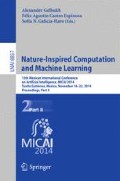Abstract
Nowadays, Data Mining has been successfully applied to several fields such as business administration, marketing and sales, diagnostics, manufacturing processes and astronomy. One of the areas where the use of Data Mining has not been well used is in the solution of social problems, where making effective decisions is essential to offering better social programs. In particular, this paper presents an analysis of Migration, which is an important social phenomenon that affects cultural, economic, ideological and demographic aspects of society, among others. This paper is based on an experiment with data processing and clustering analysis of demographic factors related to migration in the State of Hidalgo, Mexico. This study reveals the character and description of clusters obtained with data mining techniques. The knowledge from this characterization is potentially useful to government and social service agencies in the State of Hidalgo for the creation of specific social programs that might be device to mitigate the migration of the population.
Access this chapter
Tax calculation will be finalised at checkout
Purchases are for personal use only
Preview
Unable to display preview. Download preview PDF.
References
Vellido, A., et al.: Data mining of virtual campus data. In: Jain, L.C., Tedman, R.A., Tedman, D.K. (eds.) Evolution of Teaching and Learning Paradigms in Intelligent Environment. SCI, vol. 62, pp. 223–254. Springer, Heidelberg (2007)
Mateos, P., Aguilar, A.M.: Diferenciación sociodemográfica del espacio urbano de la ciudad de méxico. Revista Eure 37(110), 5–30 (2011)
Anguiano, M.: Rumbo al norte: nuevos destinos de la emigración veracruzana. Migraciones Internacionales 3(1), 82–110 (2005)
Ramírez, A.G.B.: La migración como respuesta de los campesinos ante la crisis del café: Estudio en tres municipios del estado de puebla. Revista de Sociedad, Cultura y Desarrollo Sustentable 2(2), 319–341 (2006)
CONAPO. Índice de intensidad migratoria México Estados Unidos. Secretaria de Gobernación México (2000)
Banks, D., et al.: Classification, Clustering, and Data Mining Applications. In: Proceedings of the Meeting of the International Federation of Classification Societies (IFCS). Springer, Illinois (2004)
Chávez, D., et al.: Utilización del análisis de cluster con variables mixtas en la selección de genotipos de maíz (zea mays). Revista Investigación Operacional 30(3), 209–216 (2010)
Urry, J., Gregory, D.: Social Relations and Spatial Structures. Macmillan, Basingstoke (1985)
Dunham, M.H.: Data Mining. Introductory and Advanced Topics. Prentice Hall - Pearson Education (2003)
Ferrer, V., Bosch, E.: La violencia de género: De cuestión privada a problema social. Psychosocial Intervention 9(2), 7–19 (2000)
Castro, F., et al.: Applying data mining techniques to e-learning problems. In: Jain, L.C., Tedman, R.A., Tedman, D.K. (eds.) Evolution of Teaching and Learning Paradigms in Intelligent Environment. SCI, vol. 62, pp. 183–221. Springer, Heidelberg (2007)
Mugica, F., Castro, F., Nebot, A.: On the extraction of decision support rules from fuzzy predictive models. Applied Soft Computing 11, 3463–3475 (2011)
Franco, L.M.: Migración y Remesas en la ciudad de Ixmiquilpan. Fondo Editorial UAEH (2012)
Amaru-yawa, R., Colmenares, G.: Minería de Datos aplicada a los cambios en la estructura de la variable desempleo. Caso de estudio: El estado Mérida. Universidad de Los Andes. Mérida (2007)
Garrocho, C.: Distribución espacial de la población ZMCM 1950-1990 en Estudios Demográficos y urbanos. El Colegio de México (1995)
González, J.G.: Migración y remesas en el sur del estado de méxico. In: Papeles de Población, pp. 223–252 (2006)
Guillén, T.: Entre la convergencia y la exclusión. la deportación de mexicanos desde estados unidos de américa. In: Realidad, Datos y Espacio: Revista Internacional de Estadística y Geografía, pp. 164 – 179 (2012)
Frank, E., Witten, I.H.: Data Mining Practical Machine Learning Tools and Techniques. Morgan Kaufmann (2005)
Montoya, D.M., Díaz, I.B.: Una medida de similitud basada en las modas para la caracterización de una población estudiantil en edad extraescolar. Revista de Ingenierías Universidad de Medellín 4(7), 101–109 (2005)
Pei, J., Han, J., Kamber, M.: Data Mining: Concepts and Techniques. Morgan Kaufmann (2001)
Ferri, C., Hernández, J., Ramírez, M.: Introducción a la Minería de Datos. Prentice-Hall (2005)
Ávila, M.J., Jáuregui, J.A.: Estados unidos, lugar destino para los migrantes chiapanecos. In: Migraciones Internacionales, pp. 5–38 (2007)
Arbelaitz, O., et al.: et al. An extensive comparative study of cluster validity indices. Pattern Recognition 46, 243–256 (2013)
Gutiérrez, P., et al.: Identificación de patrones característicos de la población carcelaria mediante minería de datos. In: X Workshop de Investigadores en Ciencias de la Computación, pp. 461–465 (2008)
Tafolla, R., Aguilar, S., Benítez, J.L.: Problemas sociales, económicos y políticos de México. Editorial Universidad Nacional Autónoma de, México (2006)
Yadav, R., Godara, S.: Performance analysis of clustering algorithms for character. International Journal of Advanced Computer and Mathematical Sciences 4(1), 119–123 (2013)
Serrano, T.: Migración Internacional y Pobreza en el Estado de Hidalgo. Ediciones Universidad Autónoma del Estado de Hidalgo (2006)
Sabido, M., Maldonado, R.M.: Modelo clasificador para predecir el desempeño escolar terminal de un estudiante. In: International Institute of Informatics and Systemics. Décima Conferencia Iberoamericana en Sistemas, Cibernética e Informática, pp. 25–30 (2011)
Author information
Authors and Affiliations
Editor information
Editors and Affiliations
Rights and permissions
Copyright information
© 2014 Springer International Publishing Switzerland
About this paper
Cite this paper
Franco-Arcega, A., Franco-Sánchez, K.D., Castro-Espinoza, F.A., García-Islas, L.H. (2014). Data Mining for Discovering Patterns in Migration. In: Gelbukh, A., Espinoza, F.C., Galicia-Haro, S.N. (eds) Nature-Inspired Computation and Machine Learning. MICAI 2014. Lecture Notes in Computer Science(), vol 8857. Springer, Cham. https://doi.org/10.1007/978-3-319-13650-9_26
Download citation
DOI: https://doi.org/10.1007/978-3-319-13650-9_26
Publisher Name: Springer, Cham
Print ISBN: 978-3-319-13649-3
Online ISBN: 978-3-319-13650-9
eBook Packages: Computer ScienceComputer Science (R0)

